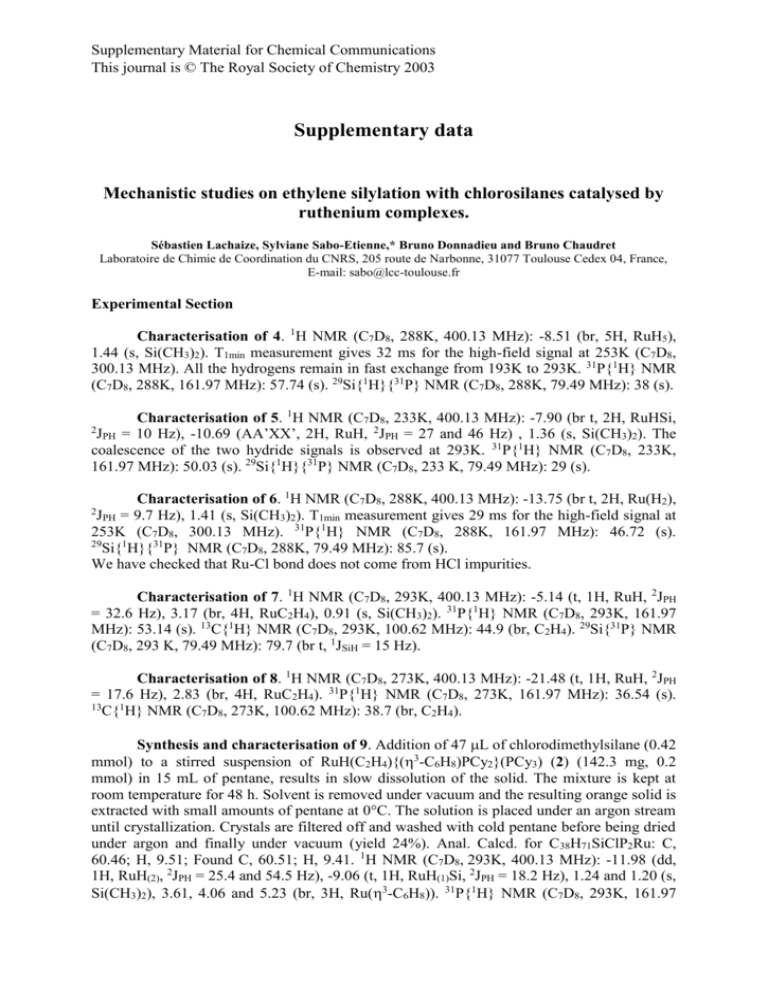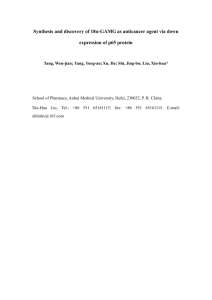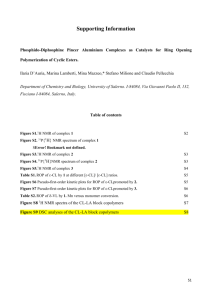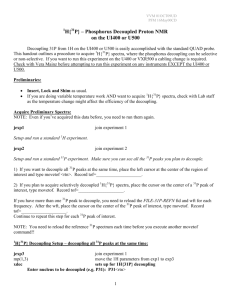Experimental details
advertisement

Supplementary Material for Chemical Communications
This journal is © The Royal Society of Chemistry 2003
Supplementary data
Mechanistic studies on ethylene silylation with chlorosilanes catalysed by
ruthenium complexes.
Sébastien Lachaize, Sylviane Sabo-Etienne,* Bruno Donnadieu and Bruno Chaudret
Laboratoire de Chimie de Coordination du CNRS, 205 route de Narbonne, 31077 Toulouse Cedex 04, France,
E-mail: sabo@lcc-toulouse.fr
Experimental Section
Characterisation of 4. 1H NMR (C7D8, 288K, 400.13 MHz): -8.51 (br, 5H, RuH5),
1.44 (s, Si(CH3)2). T1min measurement gives 32 ms for the high-field signal at 253K (C7D8,
300.13 MHz). All the hydrogens remain in fast exchange from 193K to 293K. 31P{1H} NMR
(C7D8, 288K, 161.97 MHz): 57.74 (s). 29Si{1H}{31P} NMR (C7D8, 288K, 79.49 MHz): 38 (s).
Characterisation of 5. 1H NMR (C7D8, 233K, 400.13 MHz): -7.90 (br t, 2H, RuHSi,
JPH = 10 Hz), -10.69 (AA’XX’, 2H, RuH, 2JPH = 27 and 46 Hz) , 1.36 (s, Si(CH3)2). The
coalescence of the two hydride signals is observed at 293K. 31P{1H} NMR (C7D8, 233K,
161.97 MHz): 50.03 (s). 29Si{1H}{31P} NMR (C7D8, 233 K, 79.49 MHz): 29 (s).
2
Characterisation of 6. 1H NMR (C7D8, 288K, 400.13 MHz): -13.75 (br t, 2H, Ru(H2),
JPH = 9.7 Hz), 1.41 (s, Si(CH3)2). T1min measurement gives 29 ms for the high-field signal at
253K (C7D8, 300.13 MHz). 31P{1H} NMR (C7D8, 288K, 161.97 MHz): 46.72 (s).
29
Si{1H}{31P} NMR (C7D8, 288K, 79.49 MHz): 85.7 (s).
We have checked that Ru-Cl bond does not come from HCl impurities.
2
Characterisation of 7. 1H NMR (C7D8, 293K, 400.13 MHz): -5.14 (t, 1H, RuH, 2JPH
= 32.6 Hz), 3.17 (br, 4H, RuC2H4), 0.91 (s, Si(CH3)2). 31P{1H} NMR (C7D8, 293K, 161.97
MHz): 53.14 (s). 13C{1H} NMR (C7D8, 293K, 100.62 MHz): 44.9 (br, C2H4). 29Si{31P} NMR
(C7D8, 293 K, 79.49 MHz): 79.7 (br t, 1JSiH = 15 Hz).
Characterisation of 8. 1H NMR (C7D8, 273K, 400.13 MHz): -21.48 (t, 1H, RuH, 2JPH
= 17.6 Hz), 2.83 (br, 4H, RuC2H4). 31P{1H} NMR (C7D8, 273K, 161.97 MHz): 36.54 (s).
13
C{1H} NMR (C7D8, 273K, 100.62 MHz): 38.7 (br, C2H4).
Synthesis and characterisation of 9. Addition of 47 L of chlorodimethylsilane (0.42
mmol) to a stirred suspension of RuH(C2H4){(3-C6H8)PCy2}(PCy3) (2) (142.3 mg, 0.2
mmol) in 15 mL of pentane, results in slow dissolution of the solid. The mixture is kept at
room temperature for 48 h. Solvent is removed under vacuum and the resulting orange solid is
extracted with small amounts of pentane at 0°C. The solution is placed under an argon stream
until crystallization. Crystals are filtered off and washed with cold pentane before being dried
under argon and finally under vacuum (yield 24%). Anal. Calcd. for C38H71SiClP2Ru: C,
60.46; H, 9.51; Found C, 60.51; H, 9.41. 1H NMR (C7D8, 293K, 400.13 MHz): -11.98 (dd,
1H, RuH(2), 2JPH = 25.4 and 54.5 Hz), -9.06 (t, 1H, RuH(1)Si, 2JPH = 18.2 Hz), 1.24 and 1.20 (s,
Si(CH3)2), 3.61, 4.06 and 5.23 (br, 3H, Ru(3-C6H8)). 31P{1H} NMR (C7D8, 293K, 161.97
Supplementary Material for Chemical Communications
This journal is © The Royal Society of Chemistry 2003
MHz): 68.80 and 83.93 (d, JPP = 18.6 Hz). 29Si{1H}{31P} NMR (C7D8, 293K, 79.49 MHz):
46.2 (s) and 1D HMQC 29Si-1H{31P} NMR: JSiH(1) = 37.3 and JSiH(2) = 24.1 Hz.
NMR studies
The ratio between 4, 5 and 6 is highly dependent on the excess of HSiMe2Cl. When 10
equiv. are used, 4, 5 and 6 are respectively observed in a 3:3:1 ratio, whereas with 2 equiv., 4
and 6 are in a ratio 3:1, with 5 present as traces.
X-ray data
Within the fragment Si(CH3)2Cl, one methyl and the chlorine showed statistic
disorders. The disordered model was refined using the available tools included in the
SHELXS software. Occupancies factors were refined using a free variable with an overall
isotropic thermal parameter. Once determined, the occupancy factors were fixed. The atoms
in this disorder were allowed to refine freely. After the last cycles of refinement, no
significant features in final difference maps were observed in the region around the
disordered model.
Concerning the localisation of hydrogen atoms near the Ruthenium, there are several
arguments allowing us to think that the hydrides have been reasonably located:
The good quality of the data (19343 measured reflections, 7182 independants, Rint =
0.0305).
The low temperature used for the data collection.
The use of an Imaging Plate Detector with a low signal/noise ratio.
The located position of the hydrides could be refined without any restraints leading to
reasonable chemically bonds and distances.
The X-ray data are in complete agreement with the NMR analysis.
Nowadays a wide number of polyhydrides or dihydrogen complexes are well established by
X-Ray structural characterization, due to the last improvements of X-Ray Technology.
References: (for X Ray section)
1)
Altomare, A., Cascarano, G., Giacovazzo, G., Guagliardi, A., Burla, M.C., Polidori,
G. and Camalli, M. J. Appl. Cryst. 1994. 27, 435.
2)
SHELX97 Programs for Crystal Structure Analysis (Release 97-2). Sheldrick, G. M.
Institüt für Anorganische Chemie der Universität, Tammanstrasse 4, D-3400 Göttingen,
Germany, 1998.
3)
WINGX - 1.63 Integrated System of Windows Programs for the Solution, Refinement
and Analysis of Single Crystal X-Ray Diffraction Data. Farrugia, L. J., J. Appl. Crystallogr.
1999, 32, 837 - 838.
4)
INTERNATIONAL tables for X-Ray crystallography, 1974, Vol IV, Kynoch press,
Birmingham, England.
5)
ORTEP3 for Windows. Farrugia, L. J., J. Appl. Crystallogr. 1997, 30, 565.




